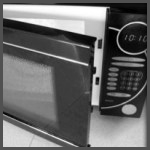True.
 This one sounds a bit hard to believe but it is true that water heated in a microwave can erupt and cause serious injury. Considering the millions of people who heat water for things like coffee and tea in microwaves, the phenomena of erupting water is rare. Think of the last time you boiled water on top of your conventional stove. Remember seeing small air bubbles form on the bottom and sides of the pot? Eventually these bubbles release from the surface of the pot, rise, and break the surface of the water. This is what we usually think of as “boiling”, the boiling point of water is 100C°. When heating water in a microwave, this normal boiling process does not occur. Rarely will you see bubbles form or boiling take place, even though the water can be extremely hot. Heating water in a microwave occurs much faster than on a normal stove, and this is one of the reasons the bubbles don’t form. The lack of bubbles actually allows the water to heat up to more than 100C, sometimes referred to as superheated water.
This one sounds a bit hard to believe but it is true that water heated in a microwave can erupt and cause serious injury. Considering the millions of people who heat water for things like coffee and tea in microwaves, the phenomena of erupting water is rare. Think of the last time you boiled water on top of your conventional stove. Remember seeing small air bubbles form on the bottom and sides of the pot? Eventually these bubbles release from the surface of the pot, rise, and break the surface of the water. This is what we usually think of as “boiling”, the boiling point of water is 100C°. When heating water in a microwave, this normal boiling process does not occur. Rarely will you see bubbles form or boiling take place, even though the water can be extremely hot. Heating water in a microwave occurs much faster than on a normal stove, and this is one of the reasons the bubbles don’t form. The lack of bubbles actually allows the water to heat up to more than 100C, sometimes referred to as superheated water.
In an article entitled Microwave Mischief and Madness, Heather Hosack and colleagues (2002) write “Superheated water will flash boil or geyser out of the container if boiling is suddenly triggered by vibration, or by an object (like a spoon) or a powder or your upper lip.” Imagine if this happened while you were bringing the cup out of the microwave, it could cause the extremely hot water to erupt in your face or spill onto a nearby child. To prevent this from happening, add something to the water (e.g., sugar, wooden stir stick) before heating, let heated water sit for 1-2 minutes before moving, or use a container which is slightly scratched on the inside (helps with the formation of bubbles).
Reference:
Hosack H, Marler N, Maclsacc D: Microwave mischief and madness. The Physics Teacher (2002), Vol 40, pps. 264-266.
